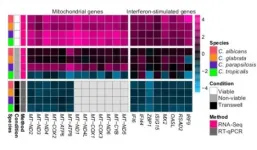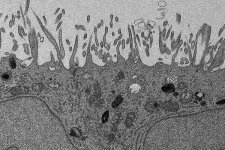Identifying banknote fingerprints can stop counterfeits on streets
2021-03-23
(Press-News.org) In 2016 the Bank of England introduced plastic (polymer) banknotes, alongside 50 other countries that use polymer banknotes
Counterfeit polymer banknotes on the streets have increased over the last few years, therefore the need to prevent and identify counterfeit banknotes has increased
Using a technique called Polymer Substrate Fingerprinting, researchers from the University of Warwick are able to identify each banknote's own fingerprint, which is unique and unclonable
Since the introduction of plastic (polymer) banknotes in 2016, the number of counterfeit notes on the streets has increased, however, researchers from Department of Computer Science at the University of Warwick have developed a novel technique called Polymer Substrate Fingerprinting, which identifies every banknote's fingerprint which is unique and unclonable.
Polymer £5 notes were introduced to the UK in 2016, with the £10 note following in 2017 and the £20 note in 2020, however as polymer banknotes have been introduced to the UK, the number of counterfeit banknotes has also increased.
Researchers from the Department of Computer Science at the University of Warwick and their collaborator from Durham University, have had the paper 'Anti-Counterfeiting for Polymer Banknotes Based on Polymer Substrate Fingerprinting', published in the journal IEEE Transactions on Information Forensics and Security, in which they propose a novel technique called Polymer Substrate Fingerprinting, which can identify each banknote's own unique, unclonable fingerprint.
Researchers have found that every polymer banknote has a unique "fingerprint", which is caused by the inevitable imperfection in the physical manufacturing process, whereby the opacity coating, a critical step during the production of polymer notes, leaves an uneven coating layer with a random dispersion of impurities in the ink. This imperfection results in random translucent patterns when a polymer banknote is back-lit by a light source.
Researchers have further presented a low-cost method to reliably capture these patterns, by using a commodity negative-film scanner, and processed them into a compact 2048-bit feature vector (fingerprint), to uniquely identify each individual banknote with extremely high accuracy.
The image analysis focuses on a small feature area, where the random translucent patterns from the opacity coating layer are directly exposed without being obstructed by security printing. For the example of the £10, the feature is chosen between the 'ten' hologram, and the see-through window. The random patterns extracted from the opacity coating layer form the unique 'fingerprint' is further protected by a veneer finish applied on both sides of the polymer note, and hence, is robust against rough handling in daily usage, similar to how the human iris is protected by the clear cornea in iris recognition.
Using 340 banknotes the researchers collected an extensive dataset of 6,200 sample images, and have proven that their method can identify each banknotes fingerprint successfully despite rough-daily handling.
Sheng Wang, a PhD student from the Department of Computer Science who has been designing, prototyping and testing this technique for that last two and half years comments:
"Although card and contactless payments tend to be more popular today banknotes still play a crucial role in society. In fact, there are 500 billion banknotes in circulation in the world, meaning counterfeit notes are a major threat to society and economy.
"Polymer banknotes have existing anti-counterfeit features, however we've found a new way to identify counterfeit notes without changing the manufacturing process, as the negative-film scanner can pick up each banknote's unique fingerprint which cannot be cloned.
"We have also found the extracted fingerprints contain around 900 bits of entropy, which is dramatically higher than 249-bit entropy for iris-codes used in iris recognition. This high entropy makes our method extremely scalable to identify every polymer note globally."
Professor Feng Hao, from the Department of Computer Science comments:
"Like every human has unique biometric features, we have found every polymer banknote has its own 'bio-metric', which is unique, naturally occurring, and can't be physically cloned. This new finding gives us the basis to design a completely new anti-counterfeiting method for banknotes.
"It is universally believed that once counterfeiters have access to essentially the same printing equipment and ink as used by legitimate government to print fake banknotes the game is over, as there will be no way to distinguish genuine and fake banknotes. Contrary to this belief our research shows, perhaps surprisingly, that there is still hope to defeat counterfeiting even in that extreme scenario."
INFORMATION:
[Attachments] See images for this press release:

ELSE PRESS RELEASES FROM THIS DATE:
2021-03-23
Maps generally indicate elevation in meters above sea level. But sea level is not the same everywhere. A group of experts headed by the Technical University of Munich (TUM), has developed an International Height Reference System (IHRS) that will unify geodetic measurements worldwide.
How high is Mount Everest? 8848 meters? 8844 meters? Or 8850 meters? For years, China and Nepal could not agree. In 2019, Nepal sent a team of geodesists to measure the world's highest mountain. A year later a team from China climbed the peak. Last December the ...
2021-03-23
A gene not previously linked to cancer has been shown to play a key role in the spread of certain cancers to the lungs, new research from scientists at the Wellcome Sanger Institute has shown. The team found that when the gene LRRN4CL was over-expressed in mice, the skin cancer melanoma was more likely to metastasise to the lungs.
The study, published today (23 March 2021) in Communications Biology, also confirmed that over-expression of LRRN4CL was linked to metastasis of colon, breast and bladder cancers to the lung.
Several factors make LRRN4CL an attractive drug target. It encodes a protein found on the surface of cancer cells, making it easier to target with drugs. And because it is expressed at low levels elsewhere in the body, it may ...
2021-03-23
WINSTON-SALEM, N.C. - March 22, 2021 - The fear, anxiety and stress associated with the COVID-19 pandemic has taken a toll on mental health. But a new study suggests these symptoms may be alleviated through safe and convenient online mindfulness practices.
The study, which was recently published in the journal Global Advances in Health and Medicine, shows that an online mindfulness intervention may reduce momentary stress, anxiety and COVID-19 concern.
At the onset of the pandemic, Rebecca Erwin Wells, M.D., M.P.H., associate professor of neurology at Wake Forest School of Medicine, part of Wake Forest Baptist Health, and principal investigator ...
2021-03-23
Fatigue, depression, sleep disorders, burnout: the number of cases where employees are unable to work for mental health-related reasons has increased dramatically in recent years. Professor Sascha Alavi, Chair at the Sales Management Department (SMD), has long been keeping a critical eye on this development in society, especially in the corporate world. Together with his former PhD student Dr. Kim Linsenmayer and Professor Johannes Habel from the University of Houston, Alavi has now demonstrated in the Journal of Marketing the negative effects that pressure in the form of performance-based remuneration schemes can have on health. Rubin, the science magazine from RUB, reports on this.
In ...
2021-03-23
Knee osteoarthritis is a painful condition that affects over 14 million U.S. adults, many of whom have extreme obesity, defined by body mass index (BMI) greater than 40kg/m2. Total knee replacement (TKR) is often recommended to treat advanced knee osteoarthritis, but surgeons may be hesitant to operate on patients with extreme obesity due to concerns about the increased risks of tissue infection, poor wound healing and higher risk of implant failure. Using an established, validated and widely published computer simulation called the Osteoarthritis Policy (OAPol) Model, researchers from Brigham and Women's Hospital, together with collaborators from Yale and Boston University ...
2021-03-23
Candidiasis is a fungal infection caused by a yeast called Candida. It is a serious global health problem and it can be vaginal, oral or systemic. The latter is the most severe form of infection, as it can lead to death, but vaginal candidiasis infection is the most prevalent, affecting 80% of women at some point in their lives.
Scientists led by Dr. Toni Gabaldón, ICREA researcher and group leader at the Institute for Research in Biomedicine (IRB Barcelona) and the Barcelona Supercomputing Center (BSC), in collaboration with Dr. Bernhard Hube's group at the Hans Knoell Institute and the University of Jena in Germany, have described the various mechanisms used by the fungus Candida to infect the ...
2021-03-23
LA JOLLA, CA--A discovery involving multiple teams from across Scripps Research has revealed a powerful new approach for treating diabetic foot ulcers, which affect millions of people in the US and often lead to serious complications.
By targeting a gene that controls tissue growth and regeneration, the scientists were able to boost cell division at the site of injury and repair chronic wounds quickly. The new research appears in Nature Chemical Biology.
Given the growing prevalence of diabetes and limited options for treating foot ulcers--which can lead to amputation, in severe cases--it's clear that more effective treatments are needed, says chemist Michael ...
2021-03-23
Metal-insulator transition (MIT) driven by many-body interactions is an important phenomenon in condensed matter physics. Exotic phases always emerge around the metal-insulator transition points where quantum fluctuations arise from a competition among spin, charge, orbital, and lattice degrees of freedom. Two-dimensional (2D) materials are a large class of materials. Their simple structure, low dimensionality, and highly tunable carrier density make them an ideal platform for exploring exotic phases. However, the many-body interactions are normally weak in most 2D materials, hence, the correlation-related phenomena ...
2021-03-23
Call it the evolutionary march of the penguins.
More than 50 million years ago, the lovable tuxedoed birds began leaving their avian relatives at the shoreline by waddling to the water's edge and taking a dive in the pursuit of seafood.
Webbed feet, flipper-like wings and unique feathers all helped penguins adapt to their underwater excursions. But new research from the University of Nebraska-Lincoln has shown that the evolution of diving is also in their blood, which optimized its capture and release of oxygen to ensure that penguins wouldn't waste their ...
2021-03-23
LA JOLLA, CA--An analysis of thousands of genomes from people with and without the rare eye disease known as MacTel has turned up more than a dozen gene variants that are likely causing the condition to develop and worsen for a significant share of patients.
The discovery, by a team of scientists from Scripps Research and the Lowy Medical Research Institute, in collaboration with Columbia University in New York and UC San Diego, provides a new avenue to pursue for diagnosis and treatment. It also sheds light on fundamental aspects of metabolism in the retina, a tissue with one of the highest energy demands in the human body. Findings appear today in the journal Nature Metabolism.
"It's exciting to uncover new answers to the ...
LAST 30 PRESS RELEASES:
[Press-News.org] Identifying banknote fingerprints can stop counterfeits on streets






